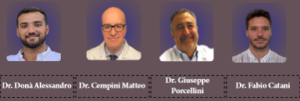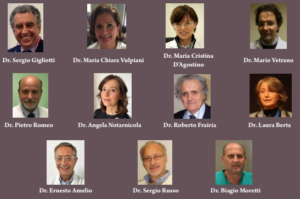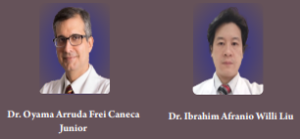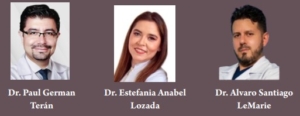Scientific Evidence of Shock Waves in Orthopedics and Traumatology: It is Time to Set the Record Straight
Editorial | Vol 3 | Issue 1 | Jan – June 2023 | page: 01-06 | Daniel Moya, Sun Wei, Claudio Simplicio, Leonardo Guiloff, Park Kwangsun, Alfonso Di Giorno, Osvaldo Valle, Josep Pous, Ram Chidambaram, Edson Serrano, Víctor Burgos Elía, Paul Terán, Laura Tutte, Fidel Gómez, Paul Patiño, Germán Solano, Jannety Berty Tejedas, Sergio Ajsiv, Graciela Moya
DOI: 10.13107/jrs.2023.v03.i01.67
Author: Daniel Moya [1], Sun Wei [2], Claudio Simplicio [3], Leonardo Guiloff [4], Park Kwangsun [5], Alfonso Di Giorno [6], Osvaldo Valle [7], Josep Pous [8], Ram Chidambaram [9], Edson Serrano [10], Víctor Burgos Elía [11], Paul Terán [12], Laura Tutte [13], Fidel Gómez [14], Paul Patiño [15], Germán Solano [16], Jannety Berty Tejedas [17], Sergio Ajsivinac [18], Graciela Moya [19]
[1] Department of Orthopaedics, Hospital Británico de Buenos Aires, Buenos Aires, Argentina,
[2] Shockwave Center, Department of Orthopedics, China-Japan Friendship Hospital, Chaoyang, Beijing, China,
[3] Clinica Ortofisio, Araruama, Río de Janeiro, Brazil,
[4] Department of Traumatology and Orthopedics, University of Chile, Founding Partner and Past President of ACHITOC and ONLAT, Chile,
[5] Seoul Sun Orthopedics Clinic and Vascular Pain Clinic, Seoul, Korea,
[6] Di Giorno Rehabilitation Medical Centers, Focused Shockwave Specialist, Bologna, Italy,
[7] Department of Orthopedic Surgeon, Ankle and Foot Team, MEDS Clinic, Santiago de Chile,
[8] CEMATEC (Centros de Medicina Avanzada y Tecnológica), Barcelona, Spain,
[9] MS Ortho, DNB Ortho, FRCS Surgery (Glasgow), FRCS Tr & Orth (UK). Director, Shoulder, Elbow & Hand Unit MGM Healthcare, Chennai, India.,
[10] Orthopaedic Surgeon. Centro Médico Especializado Neomedica, Lima, Perú,
[11] Coordinator Rehabilitation Service, Corporativo Hospital Satélite, Estado de México, México,
[12] Department of Traumatology and Orthopedics, Orthopedic Specialties Center, Quito, Ecuador,
[13] Department of Rehabilitation, Seguro Americano-Medicina Privada, Montevideo, Uruguay,
[14] Unidad de Medicina Regenerativa, Clinica Ortopédica Traumatocenter, Luque, Paraguay,
[15] Artrocentro, Santa Cruz de la Sierra, Bolivia,
[16] Orthopaedic Surgeon, Clínica Bíblica, Santa Ana, San José, Costa Rica,
[17] Specialist in Physical Medicine and Rehabilitation, Chair Clínica Central Cira García, La Habana, Cuba,
[18] Head of Department of Physiatry, Hospital Nacional de Ortopedia y Rehabilitación Dr. Jorge Von Ahn, Ciudad de Guatemala, Guatemala.
[19] Department of Bioethics Institute, Medical Science School, Buenos Aires Pontifical Catholic University, Argentina.
Address of Correspondence
Dr. Daniel Moya,
Department of Orthopaedics, Hospital Británico de Buenos Aires, Buenos Aires, Argentina.
E-mail: drdanielmoya@yahoo.com.ar
Editorial:
“Stephen Burkhart, a pioneer in arthroscopic shoulder surgery, in his keynote address at the World Congress of Shoulder and Elbow Surgery held in Buenos Aires in 2019, asked himself whether this surgical technique could have been developed during the 21st century, the age of evidence-based medicine, and FDA restriction policies [1]. Shoulder arthroscopy is today an accepted and recognized practice by all health insurance companies in the world. However, it must be recognized that its development in shoulder pathology began in the mid-1980s, when the pressure of evidence was much less pronounced. This allowed faster development and massive recognition from insurers. The advent of shock waves in musculoskeletal pathology started in the late 90’s. The publication of a special volume on this subject in 2001 in Clinical Orthopedics, under the coordination of Ogden [2], could be considered a milestone. From that moment, the technique was widely disseminated, but unlike arthroscopy, it has not achieved mass acceptance in the medical field or recognition by most health agencies and insurance companies [3-12]. A few months ago, the National Evidence-based Health-care Collaborating Agency of Korea issued an extremely critical report about the scientific evidence that supports the indications for shock waves [12]. This is not an isolated case; there are numerous examples of health technology assessment agencies and health insurance companies that question the scientific evidence behind shock waves. This determines that reimbursements are not made to patients, but above all it questions not only the effectiveness of the method but also the suitability of the professional who recommends it. Clinical experts experience in many patients shows that shock waves can produce results that would not be possible to achieve with other non-invasive methods. Clinical data comparing previous and post-treatment studies shows an objective positive response that cannot be attributed to a placebo effect (Fig. 1). So, why are there such conflicting criteria between practice, published evidence, and health agencies? Undoubtedly, the current situation is the consequence of the actions of many parties involved; including researchers, industry, state agencies, insurance companies, health professionals, and epidemiologists. It seems that each one approaches the subject from a biased position with a marked preconception about the effectiveness or
uselessness of shock waves.
Are the Current Evidence-based Medicine Reports a Guarantee of Efficacy to Analyze the Indications of Shock Waves?
In 1991, Guyatt introduced the concept of “evidence-based medicine” [13]. It is defined as the use of the scientific method to organize and apply current data to improve health-care decisions [14]. This approach gained great popularity. Health Technology Assessment agencies provide information about medical, economic, social, and ethical issues related to the use of a health technology based on levels of evidence. Reports about evidence from institutions such as the Cochrane Collaboration are highly valued. However, with regard to shock waves, the quality of the reports is in many cases highly debatable. Frequently, emphasis is placed on methodological and statistical factors, which of course is good, but not on the technical aspects of the method. An example is the study of Buchbinder et al. on the use of shock waves in chronic epicondylopathy [15]. The authors concluded that there was “Platinum” level evidence that shock wave therapy provides little or no benefit in terms of pain and function in lateral elbow pain. However, Rompe and Maffulli [16] revealed serious errors in this systematic review based on the inclusion of heterogeneous studies and errors in the shock wave application technique in several cases. Surace et al. [17] discussed the results of “shock wave therapy” in “rotator cuff disease with or without calcification,” with a similar misleading approach. First, they include two differentiate clinical conditions, calcified and non-calcified tendinopathies of the rotator cuff, which have in common their anatomical location only. While a calcification settles by definition in a rotator cuff with regenerative capacities, non-calcified tendinopathy is a degenerative and progressive condition. This is like trying to compare the outcomes of treatments for pneumonia with lung cancer simply because both diseases are located in the lungs. Second, the authors considered focused shock waves and radial pressure waves as the same treatment, when the physical parameters of these mechanical waves are absolutely different [18]. The modes of action and the effects of radial pressure waves on living tissue are different from those of focused shockwaves because bioeffects are related to the pressure waveform [19]. Hence, it is not a proper scientifical approach to consider both of them as the same treatment just because the market named both methods similarly. Nowadays, numerous studies have shown that the best results in the treatment of rotator cuff calcifications are generated from the application of high energy [20-22]; however, the systematic review, we discuss, also includes studies with radial pressure waves that do not reach those energy levels. Although the values of evidence-based medicine are useful, its mode of implementation has been discussed in recent times [23-27]. Decreeing that a method is effective or not based on studies of poor clinical quality, beyond the fact that they may be correct from the statistical point of view, is like trying to end cannibalism by eating the last cannibal. These errors could be avoided by incorporating experts in shock waves and orthopedic pathology into the studies, working jointly with epidemiologists.
What About the Quality of Scientific Literature?
Surgical techniques already installed in our daily practice are usually approved by insurance companies and health technology assessment agencies despite having debatable scientific evidence to support their use. Blom et al. [28] demonstrated that many of the 10 most indicated surgical procedures in orthopedics and traumatology are not supported by studies with a high level of evidence. This is not surprising, as it has been reported poor quality research methodology in the orthopedic literature [29]. Poolman et al. suggested that readers should not assume that studies labeled as “Level I” necessarily have high reporting quality [30]. Ionnanidis stated that for many scientific fields, “claimed research findings may often be simply accurate measures of the prevailing bias [31].” Jager and Leek estimated that the proportion of false positive findings was between 14% and 29% in 100 published clinical studies that they attempted to replicate [32]. We have also witnessed a large number of surgical procedures that had an exponential growth after being approved by health systems, ended up falling into disuse after a few years because same outcomes with conservative treatment were demonstrated. Good examples of this are acromioplasty [33, 34] and the repair of injuries in the superior labrum of the shoulder [35, 36]. It is impossible to draw an accurate conclusion based on inadequate studies. Shock wave studies are not immune to this. In a study presented at the international shock wave congress in San Sebastián, Spain in 2017, 37 clinical trials and a clinical protocol on the use of waves in shoulder pathology were evaluated by Moya et al. [37]. The authors concluded that in 70% of them, the inclusion and/or exclusion criteria were insufficient or inadequate. This included studies that favored the use of focused shock waves and radial pressure waves and those that reported poor results. Besides this, industry influence on the results of clinical studies has also been demonstrated in other fields of orthopedics and trauma [38-42]. The contribution and role of the industry in the development of shock waves have been fundamental. Unfortunately, consciously, or unconsciously, this can generate a bias in the researchers. A paper presented at the same congress by Alfano et al. concluded that a tendency toward an increased frequency of favorable outcomes was found in shockwave papers supported by the industry [43].
What is the Role of Scientific Societies?
Given this enormous anarchy of concepts, methodologies, and criteria, the role of scientific societies is a key factor. Professional medical associations play a very important role in research, education, and dissemination of medical practices. Scientific societies and their members, who are ultimately responsible for therapeutic indications, must be considered as an essential participant in decision-making, which cannot remain solely in the hands of the market or on organizations to which the system assigns the role of judges. Scientific societies must assume their role being aware of their great responsibility. Health professionals, medical institutions, and the general public trust medical societies recommendations and guidelines. There are situations and risks of bias that should be avoid. The existence of scientific societies dedicated to the study of a specific therapeutic method implies the risk of significant bias. There is the possibility of plunging into a “collective psychosis” in which each one wants to demonstrate a greater ineffability of the method or new indications. In recent years, there has also been an increasing awareness about the extent of the financial links between medical device companies and medical institutions [44]. Institutional academic-industry relationships exist when academic institutions, or any of their senior officials, have a financial relationship with or financial interests in a public or private company [45]. It has been stated that to keep independence and integrity, “leaders of scientific associations must be free of all financial ties with the industry” [46, 47]. Although many institutions have issued conflict of interest guidelines, they are not always clear enough and their implementation is not easy. As Rothman has stated, “education must be carefully distinguished from marketing [44].” Grimshaw and Russell [48] concluded that the guidelines and recommendations of scientific societies do improve clinical practice but must be formulated based on credible evidence without conflicts of interest and on a crystal-clear methodology. In the case of radial pressure waves and focused shock waves, for years, we have followed the recommendations of the International Society for Medical Shockwave Treatment [49]. The indications have been classified into: 1 – Approved standard indications, 2 – Common empirically-tested clinical uses, 3 – Exceptional indications-expert indications, and 4 – Experimental indications. In the era before evidence-based medicine, this classification may have been useful, but it is currently not enough. It is not clear which is the methodology or level of
evidence considered to include each indication in the various categories; how these four categories are defined; what conditions a professional must meet to be considered an expert; etc. The insufficiency of this model is demonstrated by the fact that many health agencies and medical insurers do not accept it.
What is the Way we Choose?
Should a scientific society put aside what happens in the real world and continue to recycle information among a small group of members as if the method were unanimously accepted? We believe that it is important to start from a clear diagnosis of the situation. We must understand that better than looking for new indications or disseminating the use of the technique and promising information not yet published, scientific society’s members should contribute with high level of evidence studies demonstrating that radial pressure waves and focused shock waves are highly effective in specific medical indications. The way for that is to define a clear and reproducible methodology and the
development of consensus reports that represent the opinion of an ex pert workgroup. A first attempt was done few years ago. Indications in the field of orthopedics and traumatology were classified according to the recommendation
scale proposed by the Journal of Bone and Joint Surgery [19]. This initiative has been taken as a basis for designing the recommendation guides by the International Federation of Shockwave Treatment. (Fig. 2) An international initiative has been launched in this regard. However, the contribution of shock wave experts and epidemiologists is not enough. Experts and institutions dedicated to the pathology of each of the anatomical regions of the musculoskeletal system must actively participate. The preparation of recommendations for the use of shock waves should not only be the result of specialists in the subject, other specialties that are not directly involved in the technique have much to contribute. It is time to put vertical thinking aside and to promote interdisciplinary proposals putting lateral thinking into practice [1]. Scientific and technological development, understood as a means for the well-being of patients, must be above any sectorial or commercial interest. It is the responsibility of all stakeholders to consistently engage in demonstrating the usefulness of any method. Seeking excellence is always a laudable goal, but it should never become an excuse to choose the easy path of lack of action. We know that this Journal still has a lot to grow from a methodological point of view, but we believe that it is the first step in a dynamic process of growth. As the Chinese philosopher Lao-tse said: “A journey of a thousand miles begins with a first step.” If we are capable of making that long trip, we will make a great contribution to the treatment of many cases that are difficult to solve with other methods.
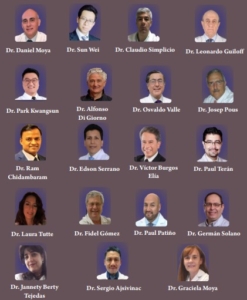
| How to Cite this article: Moya D, Wei S, Simplicio C, Guiloff L, Kwangsun P, Di Giorno A, Valle O, Pous J, Chidambaram R, Serrano E, Burgos Elía V, Terán P, Tutte L, Gómez F, Patiño P, Solano G, Tejedas JB, Ajisivinac S, Moya G | Scientific Evidence of Shock Waves in Orthopedics and Traumatology: It is Time to Set the Record Straight. | Journal of Regenerative Science | Jan – June 2023; 3(1):01-06. |
(Abstract Full Text HTML) (Download PDF)

